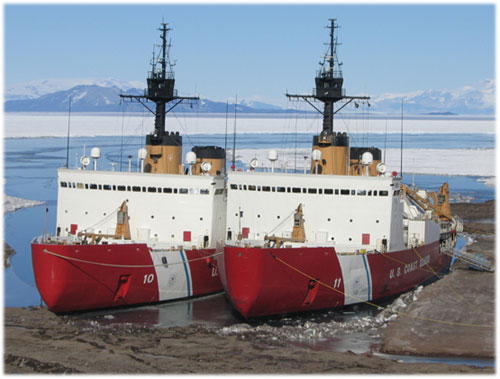 By Maggie Wall November 27, 2006
I'm vicariously living my fantasy by following the story of the Coast Guard Cutter Polar Sea, an icebreaker that departed for the southern continent Nov. 18. It's mission: to boldly go where few have gone before... sorry, I couldn't resist. Actually the Polar Sea is leading two other ships in an annual trek to refuel and replenish McMurdo Station, the primary U.S. science and logistic hub for Antarctic research efforts.  Photograph courtesy USCG
The Polar Sea's skipper is Capt. Bruce Toney, who's been to Antarctica several times on both the Sea and its sister ship the Polar Star. The Star is parked at a dock in Seattle in what's called "caretaker status," which is another way of say that this past June the ship was put into semi-retirement while the Coast Guard figures out what to do with the old, outdated ship. "In Antarctica our current primary mission is to create a channel through the fast ice to the large scientific station at McMurdp so that two large supply ships-one container ship and one oil tanker-can do the once-a-year re-supply of that station," said Toney during his visit to Kodiak. "They deliver anywhere from 6 to 8 million gallons of diesel fuel and jet fuel, and 720 20-foot containers. It's a self-un-loading container ship with its own cranes. We create that channel and we escort them, possibly tow them part of the way." The Coast Guard ship also does tug duty as needed, towing the re-supply ships off the pier or out of frozen ice as need. "Our main job is to get them in there and out," says Toney. Not an easy task given that the ice edge can extend as far as 80 nautical miles from McMurdo station. That's a lot of ice to break if it's frozen tight. Of course, our winter is their summer, so they are moving from spring to summer right now with ever increasing hours of daylight and warmer temperatures. Surely an advantage if only slight. Escort and delivery service may be the main job of the Polar Sea, but the Antarctic run, known officially as "Operation Deep Freeze," has some interesting collateral duties. "We do some science on a not-to-interfere basis. It's a secondary mission, but we may have a few scientists along to take some samples or count animal populations," said Toney. Such help may include anything from getting DNA samples from orcas to tagging penguins. And of course, there's all that sightseeing. Towering blue ice and endless white landscapes... The Polar Sea keeps its web page current while underway. Follow the trip south yourself by going to the ship's web page www.uscg.mil/pacarea/polarsea/home.htm and clicking on "Current News." FISH NEWS There's been a lot of chatter in fish press this past week about fish farming. Alaskans, who are staunchly opposed, call it fish farming. The Outside press are more and more referring to it as aquaculture, which technically it is. The difference is the picture the public draws in its mind when the subject is mentioned. Fish farming sounds down and dirty, aquaculture sounds new and improved. That's a big difference in terms of how the product will be received by the public. A Seattle Times article even praised the glories of farm raised tilapia as a gourmet faire that is sold at Costco. Greg Atkinson wrote about how "eco-friendly" tilapia is, noting that salmon are carnivorous and "present sustainability challenges because every pound of fish raised in captivity requires about two pounds of feed from wild fish." I've always heard the necessary poundage was about double that, but the interesting part followed in which Atkinson makes a point that tilapia can be raised on grain. What he fails to mention is that most tilapia farms feed their fish recycled grain-in the form of chicken poop. Picture that next time you eat a tilapia.
Publish A Letter on SitNews Read Letters/Opinions Submit A Letter to the Editor
|